The Hetzer Jagdpanzer 38(t) G-13
This German Hetzer Jagdpanzer 38t Tank Destroyer can be found at the Deutsches Panzermuseum in Munster, Germany. The G-13 designation means that it was built after WW2 for the Swiss Army.
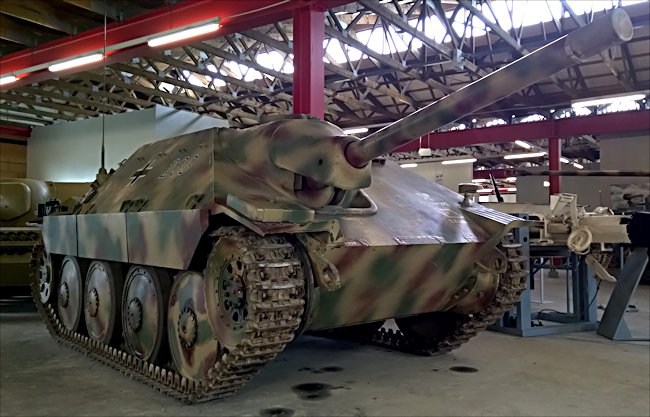
The 75mm German Hetzer Jagdpanzer 38t Tank Destroyer at the German Tank Museum, Munster.
Hetzer - The ideal Ambush Weapon
The manufacture of assault guns was more cost-effective than producing tanks the German army. The cost of producing one heavy tank, they could have three armoured mobile assault guns. They increasingly proved their worth on the battlefield. More and more resources were putting to developing new designs Jagdpanzer assault guns. Unlike with tanks, the trend was not always to build larger and heavier machines.
One vehicle that was used in rather large numbers was a tank destroyer called the 'Hetzer', which in English means 'chaser'. It was a very small, low profile vehicle based on the Czechoslovakian 38(t) tank chassis made by Skoda, but fitted with sloping armour and a very large gun.
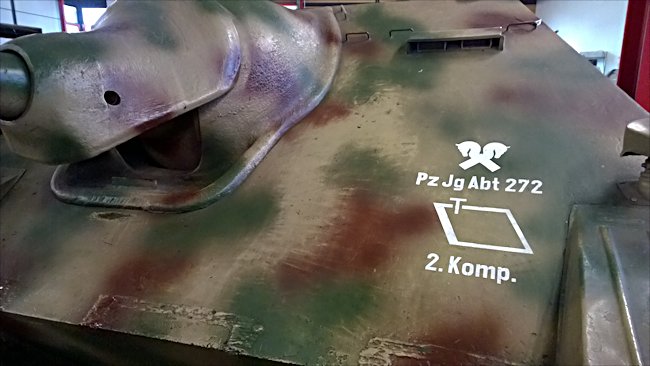
The thick armour was dovetail welded for extra strength on the German Hetzer Jagdpanzer 38t Tank Destroyer.
It only weighed 16 tonnes compared with the Jagdtiger's 70 tonnes. It had a four man crew and 60 mm of frontal sloping armour. Despite its small size, it packs a powerful punch that could knock out any Allied tank in 1944, with its 75mm PaK 39 L/48 gun. It could carry 41 rounds of ammunition, the majority of which were armour piercing.
It was designed to replace older thinly armoured an open topped Marder III Panzerjäger also use the Panzer 38(t) tank chassis. The extra armour on the Hetzer made the vehicle 5 tonnes heavier than the Marder III. The tank tracks had to be widened to take the extra load.
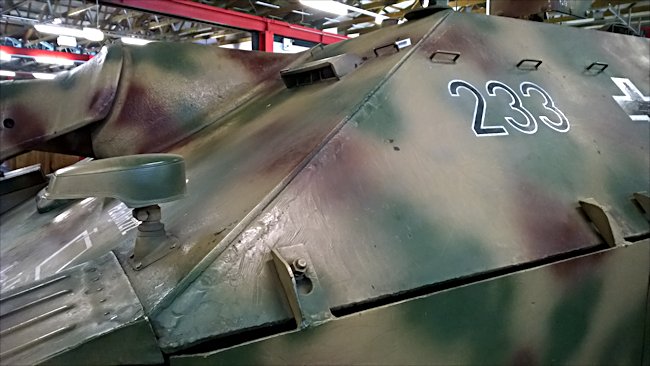
The side skirt armour could easily be fitted using a spanner on the German Hetzer Tank Destroyer. Front and side armour was sloped.
Although 60mm of frontal armour does not sound a lot, the high angle of sloped meant that in reality an Allied AP shell would have to travel through 100mm of armour. Most Allied tank guns could not do that. Many shells just bounced off the Hetzer's frontal armour.
This was not true about side armour, which will of sloped was only 20 mm thick. It was just enough to protect the crew from small arms fire and shell fragments from nearby exploding HE shells. The fully enclosed crew compartment made it a safer machine to operate than its predecessor the Marder III. To survive on the battlefield the crew had to always point the front of the vehicle towards the enemy and lookout for the danger of being flanked.
The Hetzer works best defensive situations. It was a very hard vehicle to spot when waiting motionless for the enemy to appear over a ridge, the road or across a field. It was an ideal ambush weapon.
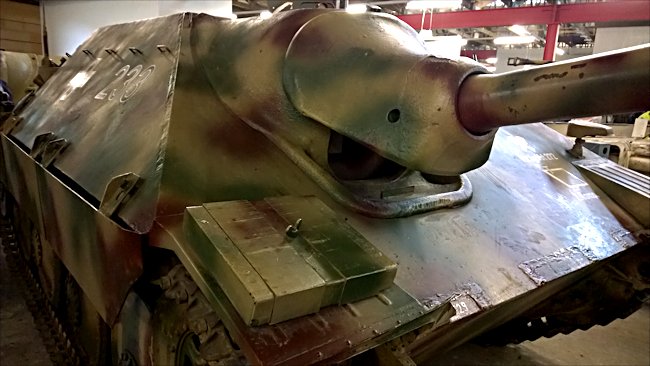
The square concrete block attached to the front of the right track cover on the Hetzer Jagdpanzer 38t Tank Destroyer is its jack base plate.
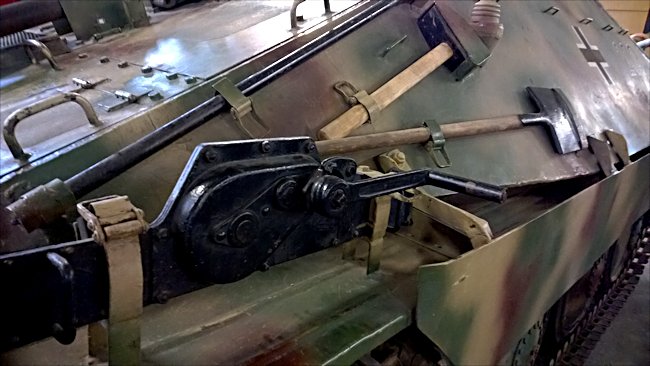
The Hetzer Jagdpanzer 38t jack and tools
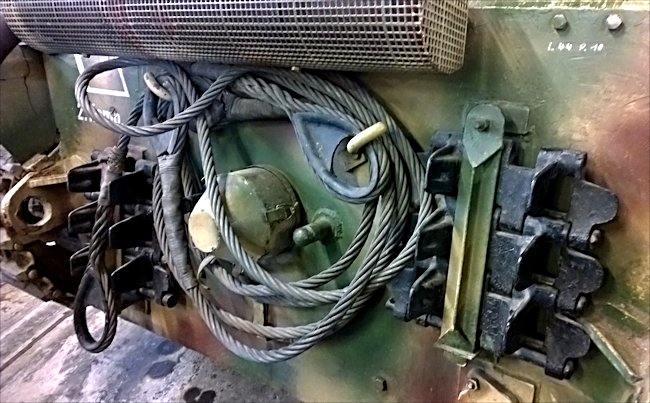
The cone shape on the back of a Hetzer Jagdpanzer 38t is a cover for the hole into which the crank handle is inserted to start the engine just like on early cars.
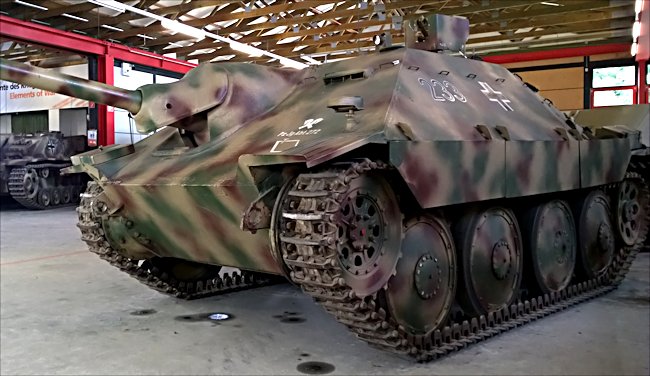
The 75mm German Hetzer Jagdpanzer 38(t) Tank Destroyer was fitted with a shielded machine gun on the top of the roof rather than one in the front armour which would have made a weak spot.
Where can I see more Hetzer 38(t) Tank Destroyers?
- Arsenalen Tank Museum, Sweden
- Bovington Tank Museum, UK
- Bruce Crompton Collection, UK
- Panzermuseum, Thun, Switzerland
- Polish Army Museum, Warsaw, Poland
- Muzeum Eksploracji Polskiej, Brzeznie,Gdansk, Poland
- Army Technical Museum, Lesany, Czech Republic
- Kubinka Tank Museum, Russia
- Australian Armour and Artillery Museum, Cairns, QLD, Australia
- Fort Lee U.S. Army Ordnance Museum, VA, USA
- Canadian Forces Base, Borden, Canada
- Rex and Rod Cadman Collection, UK (wreck)
- G13 - Arsenalen Tank Museum, Sweden
- G13 - Imperial War Museum, Duxford, UK
- G13 - 3x Kevin Wheatcroft Collection, UK
- G13 - Kevin Wheatcroft Collection, UK
- G13 - Dave Carson, UK
- G13 - Private Collection UK
- G13 - Munster Panzer Museum, Germany
- G13 - Wehrtechnische Dienststelle Meppen, Germany
- G13 - 2x Auto + Technik Museum, Sinsheim, German
- G13 - Militarhistorischen Museum der Bundeswehr, Dresden, Germany
- G13 - Infanterie Museum, Hammelburg, Germany
- G13 - Museum fur historische Wehrtechnik - Rothenbach an der Pegnitz, Germany
- G13 - Garnisongeschichtsve rein St. Barbara, Jüterbog, Germany
- G13 - National War and Resistance Museum Overloon, Netherlands
- G13 - Wings of Liberation Museum, Best, Netherlands
- G13 - Bastogne Barracks, Bastogne, Belgium
- G13 - Heintz Barracks, Bastogne, Belgium
- G13 - Bastogne Historical Center, Bastogne, Belgium
- G13 - Ardennes 44 museum, Bras, Bastogne, Belgium
- G13 - Jean Weiler, private owner, Luxembourg
- G13 - National Museum of Military History, Diekirch, Luxembourg
- G13 - 2x French Tank Museum, Saumur, France
- G13 - Battle of Normandy Museum, Bayeux, France
- G13 - Maginot Line Memorial Way, Barst, France
- G13 - Memorial Maginot de Haute-Alsace, Uffheim, France
- G13 - ASPHM Association, La Wantzenau, France
- G13 - Association de Sauvegarde du Patrimoine Historique Militaire. 1 Rue Georges Cuvier, La Watzenau, France
- G13 - 2x Panzermuseum, Thun (Switzerland
- G13 - Army Base, Thun, Switzerland
- G13 - 4x Armeemuseum, Burgdorf, Switzerland
- G13 - Militarmuseum, Wildegg, Switzerland
- G13 - Museum in Zeughaus Schaffhausen, Switzerland
- G13 - 3x Schweizerisches Militärmuseum, Full, Switzerland
- G13 - Army base, Hinwil, Switzerland
- G13 - Private owner, Hilfikon, Switzerland
- G13 - Swiss Army fire range, Vugelles, Switzerland
- G13 - Pré-Giroud Fort Museum, Le Day, Switzerland
- G13 - Army base, Bure, Switzerland
- G13 - Army base, Aigle, Switzerland
- G13 - Lehrsammlung der Panzertruppenschule Zwolfaxing, Austria
- G13 - Panzerfarm, Keszycki Brothers Collection, Poland
- G13 - Ireneusz Hryniak collection, Kawice, Poland
- G13 - Handmet Military, Gostyn, Poland
- G13 - Army Technical Museum Lesany, Czech Republic
- G13 - Lehar Military Vehicles, Zabreh, Czech Republic
- G13 - Private Collection, Ukraine
- G13 - Royal Tank Museum KADD, Jordan
- G13 - The Collings Foundation, Stow, MA, USA
- G13 - Virginia Museum of Military Vehicles Nokesville, VA, USA
- G13 - National Armor and Cavalry Museum, Fort Benning, GA, USA
- G13 - Dave Crompton Collection, MI, USA
- G13 - 2nd Panzer Division Association, IL, USA
- G13 - Texas Military Museum, Camp Mabry,Austin, TX, USA
- G13 - Old Ironsides Museum, Fort Bliss, TX, USA
- G13 - Flying Heritage Museum, Everett, WA, USA
- G13 - 12th SS-Panzerdivision Reenactment unit, CA, USA
- G13 - Private collection, USA
- Source - Pierre-Oliver Buan - http://the.shadock.free.fr/Surviving_Panzers.html
WW2 tank books

